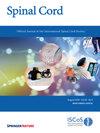Satisfaction with social roles and activities across mobility status among persons with spinal cord injury
IF 2.1
4区 医学
Q3 CLINICAL NEUROLOGY
引用次数: 0
Abstract
Cross-sectional study. To examine the differences in satisfaction with social roles and activities among ambulatory individuals, manual wheelchair users, and power wheelchair users with spinal cord injuries (SCIs). Community setting. Participants completed surveys of their demographics and clinical data as well as the Spinal Cord Injury – Quality of Life Satisfaction with Social Roles and Activities- Short Form. Participants’ mobility status was categorized into (1) ambulatory individuals, (2) independent manual wheelchair users, and (3) power wheelchair/scooter users. One-way ANOVA and ANCOVA were used, respectively, to examine unadjusted and adjusted differences in satisfaction with social roles and activities across mobility status. Adjustment covariates included age, sex, time since SCI, and SCI injury level. A total of 129 participants (mean age = 47.4 ± 13.6 years, 73% male) were included in the analyses. Unadjusted (F = 3.8, p = 0.03) and adjusted models (F = 3.4, p = 0.04) evidenced significant differences in satisfaction with social roles and activities according to mobility status. Pairwise Bonferroni Post-Hoc analysis indicated that manual wheelchair users were more satisfied with their social roles and activities when compared to ambulatory individuals (mean difference = 2.8, p < 0.05). Due to the current challenges associated with walking recovery after SCIs, clinicians may want to discuss the use of wheelchairs with individuals with limited walking ability when the goal is to improve participation and quality of life. Emphasizing alternative means of mobility may enhance satisfaction with social roles and activities.脊髓损伤者对不同行动能力的社会角色和活动的满意度。
研究设计横断面研究:考察脊髓损伤(SCIs)患者中的非卧床者、手动轮椅使用者和电动轮椅使用者对社会角色和活动满意度的差异:社区环境:参与者填写人口统计学和临床数据调查表以及脊髓损伤--社交角色和活动生活质量满意度简表。参与者的行动状况被分为:(1)行动自如者;(2)独立手动轮椅使用者;(3)电动轮椅/滑板车使用者。分别采用单因素方差分析和方差分析来检验不同行动能力状况下社会角色和活动满意度的未调整差异和调整差异。调整协变量包括年龄、性别、自 SCI 后的时间和 SCI 损伤程度:共有 129 名参与者(平均年龄 = 47.4 ± 13.6 岁,73% 为男性)参与了分析。未调整模型(F = 3.8,P = 0.03)和调整模型(F = 3.4,P = 0.04)显示,行动不便者对社会角色和活动的满意度存在显著差异。成对 Bonferroni 事后分析表明,手动轮椅使用者对其社会角色和活动的满意度高于行动不便者(平均差异 = 2.8,p 结论:手动轮椅使用者对其社会角色和活动的满意度高于行动不便者(平均差异 = 2.8,p 结论:行动不便者对其社会角色和活动的满意度高于行动不便者):鉴于目前与 SCI 后行走恢复相关的挑战,临床医生可能希望与行走能力受限的患者讨论轮椅的使用问题,以提高他们的参与度和生活质量。强调替代性移动方式可能会提高人们对社会角色和活动的满意度。
本文章由计算机程序翻译,如有差异,请以英文原文为准。
求助全文
约1分钟内获得全文
求助全文
来源期刊

Spinal cord
医学-临床神经学
CiteScore
4.50
自引率
9.10%
发文量
142
审稿时长
2 months
期刊介绍:
Spinal Cord is a specialised, international journal that has been publishing spinal cord related manuscripts since 1963. It appears monthly, online and in print, and accepts contributions on spinal cord anatomy, physiology, management of injury and disease, and the quality of life and life circumstances of people with a spinal cord injury. Spinal Cord is multi-disciplinary and publishes contributions across the entire spectrum of research ranging from basic science to applied clinical research. It focuses on high quality original research, systematic reviews and narrative reviews.
Spinal Cord''s sister journal Spinal Cord Series and Cases: Clinical Management in Spinal Cord Disorders publishes high quality case reports, small case series, pilot and retrospective studies perspectives, Pulse survey articles, Point-couterpoint articles, correspondences and book reviews. It specialises in material that addresses all aspects of life for persons with spinal cord injuries or disorders. For more information, please see the aims and scope of Spinal Cord Series and Cases.
 求助内容:
求助内容: 应助结果提醒方式:
应助结果提醒方式:


